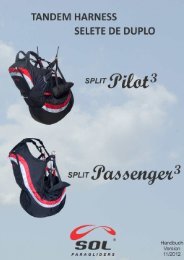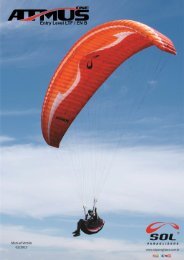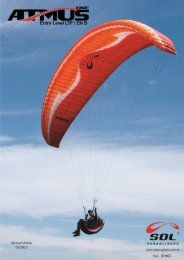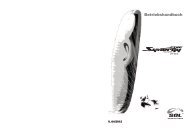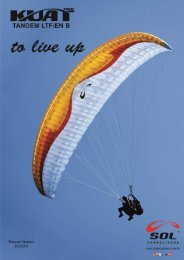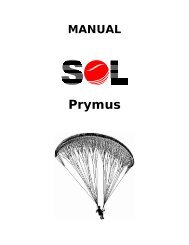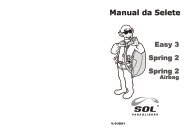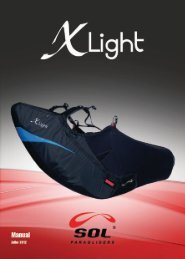You also want an ePaper? Increase the reach of your titles
YUMPU automatically turns print PDFs into web optimized ePapers that Google loves.
During flights over mountainous terrain, it is highly recommended aminimum height of 50m be kept, for safety reasons.It is extremely important to know and respect flying regulations, especiallyso when the airspace within close proximities of canyons is shared amongseveral pilots, where last minute anti-collision maneuvers are not executable.Warning:The SOL ELLUS 2 requires active flying in turbulences! This can avoid canopyclosings and deformations.ACTIVE FLIGHTFor best performance during your flight, it is important to be alwayssensitive to what your canopy is trying to communicate. The key elementsof active flying are the advancements and tension control.When the canopy moves ahead of you, carefully apply the brakes, so thatthe canopy returns to be above you, and if the canopy moves behind you,you must release the brakes.Flying with the brakes lightly applied (+ - 20 cm) allows the canopy to flyslightly behind. In turbulent circumstances the internal paraglider tensionmay change, which you will feel on the brakes. The idea is to maintain aconstant tension, and in case you feel loss of tension, lift your hands upquickly to the original position.Avoid flying excessively with the brakes on because you might brake to thepoint of stopping the canopy from flying. Always consider your aerodynamicspeed. Your movements can be symmetric or asymmetric and both or onebrake can be applied.These adjustments will make for a more controlled flight, and help ineliminating the possibility of collapse.We suggest that you do ground practice runs and advancing simulations.Tension loss can be simulated well on the ground.Warning:Neither pilot nor any paraglider are immune to collapses; thereforeactive flying will decrease the chances of happening. When flying inturbulent conditions, be more active and avoid great advancements ofthe canopy by anticipating yourself too quickly with your responsemovements. Always maintain altitude awareness and do not get intoexcessive commanding mode. We advise you to maintain brake tensionand avoid flying in extreme turbulent conditions.56Accelerated Flight:It is recommended to use the accelerator when flying against the wind or indescending current zones. Due to a decreased angle of attack, the canopymay collapse easier than when set at the normal position. The pilot mustremember that the higher the speed, the more dynamic the collapseresponse or symmetric closing will be.The Landing:It's very easy to land with the SOL ELLUS 2. The final approach stage mustbe done in straight line upwind. During this final glide, the paraglider must bedecelerated slowly and at about 1 m from the ground the pilot must stall thecanopy, according to the conditions.With a strong nose wind, the pilot should break only slightly or eventuallydon't even brake at all, and utilizing just the risers 'C' to de-inflate andovercome the canopy after the landing. By breaking during a landing instrong wind conditions, you may expose the canopy to the wind, whichcould lead to the pilot being dragged backwards.The final approach must be done always in a straight line. Sharp andalternating turns may produce a dangerous pendulum movement closeto the ground.TakeoffbyTow:The SOL ELLUS 2 does not require any special provisions to be towed.However, during takeoff a narrow angle on the cable in relation to theground must be avoided.Rain and Humidity:It is not advisable to fly the SOL ELLUS 2 in rainy days or with a wetparaglider, since the in-flight maneuvers become more sensitive and areserve deployment may occur upon exiting a B-Stoll or in the event ofexcessive usage of breaks.Motorized Flight and Acrobatic Flight:The SOL ELLUS 2 has not been designed for motorized flight, or acrobatics.Although it has been successfully used for these purposes by some pilots.57



